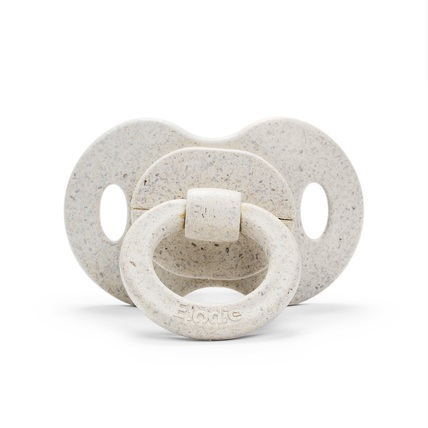The Ultimate Guide to Elodie Pacifiers
At Elodie we have been designing and producing pacifiers since 2006, and through the years many styles and variants have come and gone. Always with safety and high quality as the most important aspect, but with trend and style as a close second. Today our assortment is larger than ever, with various materials, shapes, sizes and suction teats.
But from all these size and shapes, a new parent might surely ask themselves: How do I choose the right pacifier for my kid? In this guide we introduce you to some of the details and look at the various alternatives you’ll find in Elodie’s assortment.
The five different styles
Classic Pacifiers
Our Classic pacifiers have a shield and knob that are produced using a high-quality plastic called TRITAN™ that is extremely durable and robust. It’s been in our assortment the longest and has proven time and time again that quality never goes out of style. The ability to print both the shield and knobs lets us create advanced designs that go hand-in-hand with our pacifier clips and many of our other baby products.
Bamboo Pacifiers
Next up, we have the Bamboo pacifiers – made with renewable, plant-based bamboo fibres. Elodie was the first brand in the world to develop a pacifier for families that want to make a more sustainable choice and reduce their environmental impact one pacifier at a time.
Binky Bundles
The Binky Bundle is a duo-pack of pacifiers with round teats in either natural rubber or silicone, available in both newborn and +3 month sizes. A duo-pack of pacifiers with a round retro-inspired design that is easy to fall in love with. These are available in many carefully selected colours that are perfect matches for your other Elodie gear, and lets you create perfect style combos for your little one.
Binky Bloom
These beautiful design favorites became part of Elodie's pacifier range in 2024. The pacifier has a flower-shaped shield whose appearance is unique to Elodie. They come in trendy color shades that perfectly match many other products in Elodie's assortment. The pacifier has a symmetrical suction part in silicone that is suitable for children from 3 months and up.
Binky Bow
Binky Bow was launched in 2025 and is the latest addition to Elodie's wide range of pacifiers. The pacifier has a unique bow-shaped shield and comes in two lovely color tones. The pacifier has a symmetrical silicone teat that is suitable for children from 3 months and up. A pacifier that even parents will have a hard time letting go of.
Round or Orthodontic teats?
We offer both a symmetrically round shaped teat and a more asymmetrical shape known as an orthodontic teat. The round one is slightly longer and can be useful for introducing pacifiers for the first time, as they more closely resemble the shape of a nipple. The orthodontic teats are great because they position between the top and bottom jaw which helps promote a healthy development of the gums and jaw, plus it allows for more tongue movement around the teat.
Finding the right teat shape may take time because every baby is different. Your first child may have preferred a round one, but your second baby may prefer an orthodontic one. To find your baby’s definition of the perfect pacifier, you’ll have to do some trial and error. For example, if you buy a properly sized round one and they constantly spit it out, try an orthodontic one next time.
Silicone or Latex?
The most commonly used material in pacifier teats is food grade Silicone. The main benefit of silicone is that it is strong, durable, easy to clean and has a long-life expectancy. The material does not age and does not retain any odours.
The other available alternative is Latex, sometimes referred to as natural rubber, is softer and more flexible than silicone. But these teats wear out more quickly and will need to be replaced more often. If your child has a latex allergy, you’ll need to avoid these pacifiers.
Same as with the shape of the teat, the material can be a deciding factor simply by your baby accepting one and refusing the other. If you can’t make a silicone teat work, it’s a good idea to see if your child prefers the softer feel of a latex one.
Finding the right size
The difference between pacifier sizes is the size of the teat and the mouth shield. As a baby grows, their mouth gets larger, becoming more accustomed to sucking -the strength in their mouth and tongue increases. The most important changes take place within the first few months, and we therefore offer new-born sized pacifiers with smaller shields and teats as well as larger version that is generally recommended from 3 months and on.
After the age of three months there is little need to adjust sizes, as the size your child is accustomed to will very likely be the size they prefer until it's time to wean them off the use all together. Some little ones will take longer to "graduate" from the new-born size, but keep offering them the larger teat and they will eventually accept theme.
Choose a safe pacifier
In addition to design, pacifier size and suction part, there is one aspect that weighs more heavily. The pacifier for your child must be safety tested and meet the safety requirements of the European regulation.
All Elodie pacifiers are tested and approved according to the high safety requirements of the European regulation EN:1400. In addition to testing our pacifiers, each pacifier's shield is equipped with ventilation holes that allow air to circulate around your child's mouth, which reduces the risk of skin irritation. All edges are softly rounded so as not to rub against your child's sensitive skin.
Discover Elodie's wide range of pacifiers where safety and high quality are the most important aspects, but always with trendy prints and color choices.

.jpeg)
%20kopia.jpeg)


.jpeg)

.jpeg)













